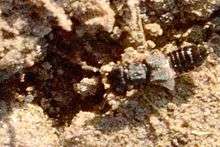Anotylus tetracarinatus
Anotylus tetracarinatus is a small rove beetle with a wide distribution. It is the most common species of the genus, and maybe even of the family, in the whole of Central Europe.
| Anotylus tetracarinatus | |
|---|---|
 | |
| A. tetracarinatus from Commanster, Belgium | |
| Scientific classification | |
| Kingdom: | |
| Phylum: | |
| Class: | |
| Order: | |
| Family: | |
| Genus: | |
| Species: | A. tetracarinatus |
| Binomial name | |
| Anotylus tetracarinatus (Block, 1799) | |
| Synonyms | |
|
Staphylinus tetracarinatus Block, 1799 | |
The beetles can cause severe pain if they come into contact with the human eye.[1][2] This pain usually lasts for about ten minutes.
Description
A. tetracarinatus reaches a length of 1.7 to 2.1 mm. The body is dark. The tibiae of the front legs are not sinuated at the tip. The abdomen of the males do not possess any protuberances.
The species develops in a variety of decaying materials. Often the imagines swarm in spring or early summer in great numbers, especially in the afternoons or evenings of warm days.
Distribution
A. tetracarinatus was first described from Plauischer Grund near Dresden,[3]:1403 but is found natively in Algeria, Europe, Russia, Turkey, Iran, United States and Canada.[3]:1403[4]
See also
- Paederus dermatitis, a related beetle that can cause dermatitis
References
- Mumcuoglu, Y.; Rufli, T.: Dermatologische Entomologie. 15. Coleoptera/Kafer. Schweizerische Rundschau fur Medizin (Praxis) 1980, recd. 1983 Vol. 69 No. 47 pp. 1750-1755 - Abstract
- Fritz Netolitzky (1919): Käfer als Nahrungs- und Heilmittel - »Aus eigener medizinischer Erfahrung kenne ich noch die starke Reizwirkung des Oxytelus tetracarinatus Block, der wohl schon jedem Radfahrer in die Augen geflogen ist; er ist die „Mücke", die unerträgliches Brennen im Auge verursacht, wenn bei Sonnenuntergang die Landstraße von diesem winzigen Dungkäfer wimmelt.«
- Herman, Lee H. 2001. Catalog of the Staphylinidae (Insecta: Coleoptera). 1758 to the end of the second millennium. III. Oxyteline group. Bulletin of the American Museum of Natural History, no. 265. 1067-1806.
- ITIS: Anotylus tetracarinatus
- Karl Wilhelm Harde, Frantisek Severa und Edwin Möhn: Der Kosmos Käferführer: Die mitteleuropäischen Käfer. Franckh-Kosmos Verlags-GmbH & Co KG, Stuttgart 2000, ISBN 3-440-06959-1.
- A. Horion: Faunistik der mitteleuropäischen Käfer Band IX: Staphylinidae 1. Teil: Micropeplinae bis Euaesthetinae, Verlagsdruckerei Ph. C. W. Schmidt, Neustadt a.d. Aisch, 1963.
- Edmund Reitter: Fauna Germanica – Die Käfer des Deutschen Reiches. 5 Bände, Stuttgart K. G. Lutz 1908–1916, Digitale Bibliothek Band 134, Directmedia Publishing GmbH, Berlin 2006, ISBN 3-898-53534-7
| Wikispecies has information related to Anotylus tetracarinatus |
| Wikimedia Commons has media related to Anotylus tetracarinatus. |